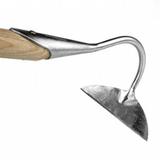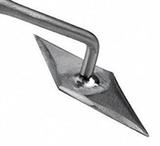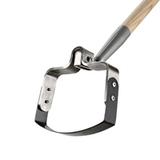Often people who come to shop with us are new to gardening and sometimes, the sheer number of different tools they see overwhelms them. Weeding tools is just such a category and the unique styles of hoes are particularly plentiful. Hoes come with almost any length handle from the hand hoe (approximately 11" to 20") to long handled hoes (approximately 60" to 72").
Pull Hoes
Pull hoes are the most traditional of the hoes and the ones most people are likely to be familiar with. Even if you haven't used one, you've likely seen them. As the name suggests, a pull hoe is used by pulling it through the dirt towards you. It moves all the soil down to the blade and across its width, creating a trough. The blade is typically slanted back towards the user on a swan shaped neck. In addition to weeding, a pull hoe can be used for planting.

Pull hoes come in different shapes, but the most common shape is the trapezoid.They are more commonly used in rows rather than in tightly planted areas because of the more squared off shape. Like all pull hoes, there are many widths and depths available.
Half moon shaped heads on pull hoes are also popular with many gardeners. The head comes to more of a point at the bottom, allowing for easier weeding between plants. Due to the curve at the top, there is also less resistance from the soil when pulled.
Push Hoes
As the name suggests, these hoes and designed to be pushed, but many of them can also be pulled. They can be used either below or at the surface and are flatter than pull hoes. Push hoes can pull the whole weed or slice them, depending on the shape and the depth at which they are used. Push hoes come in even more shapes than push hoes.

One of the most common push hoes is the Dutch hoe, while another popular shape is the diamond hoe. There are however, any number of shapes and sizes. A good pull hoe typically features more than one sharp side, and sometimes all the sides are sharp.
Oscillating Hoes
An oscillating hoe is shaped like a square with a curved bottom and they are sometimes known as hula or stirrup hoes. The curved piece at the bottom is thinner than the top and sides and sharp on both edges. They are hinged at the top and are designed to be used below the surface in a back and forth motion.
Eye Hoes
Eye hoes are the beefiest of the hoes and are designed for breaking up soil, in addition to hoeing it. The metal used is normally thicker and not as sharp as a garden hoe. An eye hoe is typically heavier and shorter as well. Like garden hoes, they come in a variety of shapes and the heads can either be one or two sided. Due to the rougher work, eye hoe handles are typically thicker than garden hoes, and these hoes are also made with both short and long handles.
So there are so many hoes and they're all about your needs and personal preferences. When we had a store, we had tools that people could try out. We had several firemen come from down the street and they were uncertain what type they wanted. We let them go out back and try a bunch out. Their picks were the diamond push hoe and the oscillating hoe, but you certainly can't go wrong with any of them.




